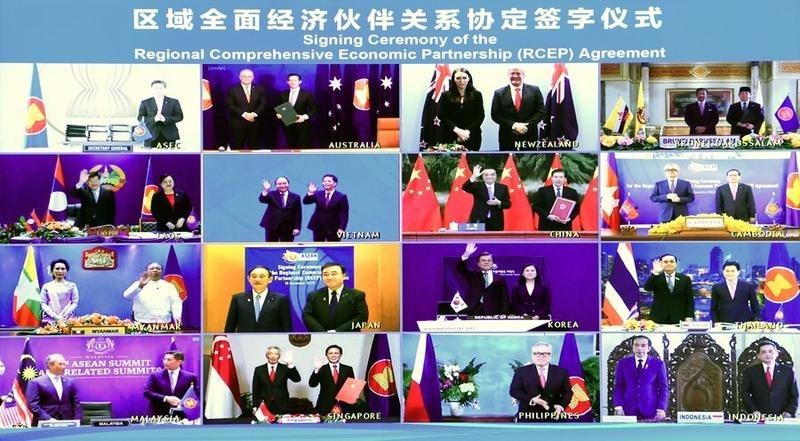 Leaders of the 15 participating countries of Regional Comprehensive Economic Partnership (RCEP) agreement attend the trade pact's signing ceremony, which is held via video link on Nov 15, 2020. (PHOTO / XINHUA)
Leaders of the 15 participating countries of Regional Comprehensive Economic Partnership (RCEP) agreement attend the trade pact's signing ceremony, which is held via video link on Nov 15, 2020. (PHOTO / XINHUA)
The Regional Comprehensive Economic Partnership agreement signed on Sunday is firm proof of China's commitment to further opening-up and dispels any notions that China's dual-circulation development pattern is exclusionist, a senior Chinese economist said.
Due to the COVID-19 pandemic, global FDI flows are forecast to decrease by up to 40 percent in 2020, from the 2019 value of US$1.54 trillion, according to UNCTAD's World Investment Report 2020
Zhang Yuyan, director of the Institute of World Economics and Politics of the Chinese Academy of Social Sciences, told a news briefing in Beijing on Tuesday that the dual-circulation development pattern, which is defined as taking the domestic market as the mainstay while letting the domestic and international markets boost each other, aims at strengthening weak links to build an integrated domestic market, so as to better participate in the international division of labor and trade and contribute to global economic development.
"Opening-up is a national fundamental policy in China, and it is already deeply rooted in Chinese people's minds that opening-up leads to development while closed-door policies make a country lag behind others," he said.
ALSO READ: RCEP agreement victory for multilateralism, free trade
The signing of the RCEP shows China's commitment to higher-level opening-up, and is also a victory for free trade, as it shows the practice of global economic and trade cooperation remains mainstream at least in Asia, if not in the world, he said.
The agreement, signed by 15 countries including China, Australia, Japan and member states of the Association of Southeast Asian Nations, is expected to lower or eliminate a wide range of tariffs on imports in the coming years.
Aside from the aim to eliminate 90 percent of the tariffs on imported goods, the adoption of unified rules under the RCEP in member countries will boost the movement of labor, capital, and other production factors between countries, and bolster trade and investment, said Zhang.
READ MORE: RCEP 'a driving force for global economy' in post-virus era
Besides, China's already shortened negative lists for foreign investment, with items on the national negative list cut to 33, demonstrate its efforts to further open up the economy and improve its business environment, he said, adding the stable inflow of foreign direct investment into China despite the COVID-19 effect underpins the nation's achievements in opening up and improving the business environment.
Due to the COVID-19 pandemic, global FDI flows are forecast to decrease by up to 40 percent in 2020, from the 2019 value of US$1.54 trillion, according to UNCTAD's World Investment Report 2020. Yet FDI into the Chinese mainland went up by 6.4 percent on a yearly basis in the first 10 months, and expanded by 18.3 percent on a yearly basis to 81.87 billion yuan (US$12.47 billion) in October in actual use, according to the Ministry of Commerce.
The new dual-circulation development pattern also shows China is diverting from low-value export-led economic development model to high-quality development, whereas a strong and highly integrated domestic market will provide a good basis for the domestic and external markets to boost each other, according to Huang Qunhui, director of the Institute of Economics at the Chinese Academy of Social Sciences.


